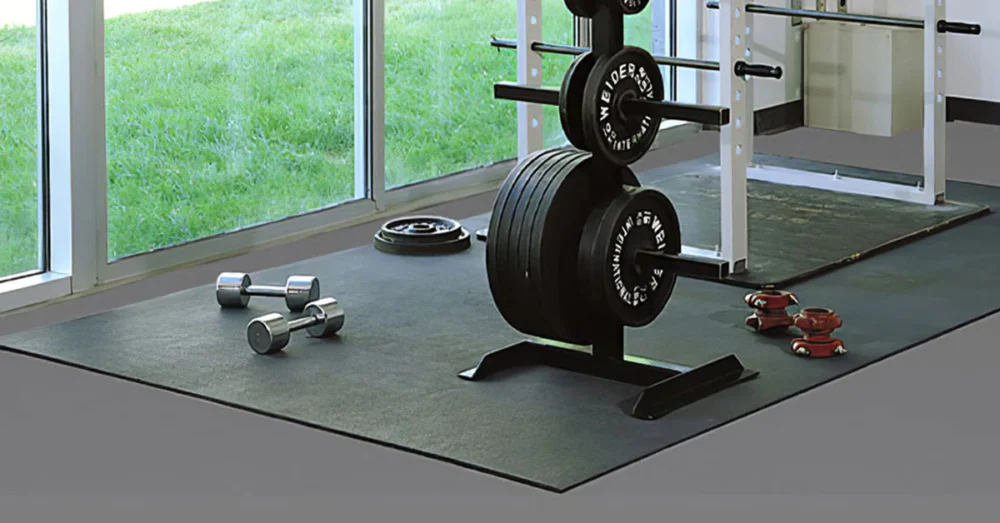Why Flooring Thickness Matters
Every gym or training facility needs gym flooring that matches the intensity of its workouts. The right thickness determines how well your floor absorbs impact, reduces noise, and protects your equipment and subfloor. Too thin, and it wears out quickly; too thick, and you may overspend or add unnecessary height.
At Fitness Flooring, Inc., headquartered in Indianapolis, IN, we help USA facility managers, architects, and gym owners choose the flooring thickness that fits their space, usage, and budget. Here’s what you need to know before ordering your next set of gym floor mats.
Understanding Gym Flooring Thickness
Gym flooring thickness is usually measured in millimetres (mm) and varies depending on how
the space is used. The thickness you choose affects:
● Shock absorption – how much impact is reduced when weights drop
● Durability – how long the flooring lasts under pressure
● Comfort – how it feels underfoot during workouts
● Noise reduction – how well it muffles sound and vibration
Choosing the correct thickness ensures long-term performance and safety in any commercial gym flooring installation.
Recommended Thickness by Area Type
Cardio Zones (6-8 mm)
A smooth, stable surface is ideal for treadmills, bikes, and ellipticals. It helps to reduce vibration and protects the subfloor.
Group Exercise Studios (8-10 mm)
This thickness provides great shock absorption, making it perfect for Zumba, HIIT, or dance activities. It’s ideal for group fitness studios.
Home Gyms (6-10 mm)
Durable, affordable, and easy to install. This is an excellent option for home gym flooring in the USA.
Multi-Purpose Gyms (8-12 mm)
Balances comfort and performance for various sports and activities, offering the perfect versatility for diverse gym settings.
Olympic or Powerlifting Areas (20-30 mm)
This thickness offers maximum protection for heavy barbell drops, making it perfect for weightlifting zones.
Weight Rooms (10-15 mm)
Handles free weights, benches, and racks while preventing indentation and cracking, ensuring long-lasting durability.
Rubber vs. Foam vs. Vinyl: Material Matters
Thickness is only part of the decision material selection is equally important.
Rubber Flooring
The industry standard for commercial fitness spaces. Durable, slip-resistant, and perfect for non-slip gym flooring applications. Rubber tiles or rolls are available in multiple thicknesses and perform well in both indoor and outdoor fitness areas.
Foam Mats
Lightweight and comfortable, best for yoga, Pilates, or stretching zones. Not suitable for heavy weights or machines due to compression.
Vinyl Sports Flooring
Popular for dance studio flooring and multi-purpose gym setups. It provides excellent traction and can be installed over rubber underlayment for added shock absorption.
How Thickness Impacts Performance
- Safety: Thicker flooring provides better protection for athletes and equipment, reducing the risk of joint injuries and floor damage.
- Sound and Vibration Control: Heavier mats minimize noise from dropped weights and repetitive movements, especially valuable in commercial fitness centers and corporate gyms.
- Durability: A thicker surface lasts longer and resists indentation from racks, benches, and machines.
- Maintenance: Proper thickness simplifies cleaning and replacement since mats maintain their shape and seal better over time.
Installation Tips from Fitness Flooring Experts
- Assess the subfloor – concrete surfaces need thicker mats to prevent cracking and noise transmission.
- Plan by zone – use different thickness levels for each area instead of one size for the entire facility.
- Hire certified installers – Fitness Flooring, Inc. (Indianapolis, IN) provides professional installation services.
- Account for height changes – adjust when adding flooring under doors or equipment.
Partnering with experienced gym floor installers guarantees safety and performance that meets
professional standards.
Common Mistakes to Avoid
- Choosing too thin a mat for high-impact or weightlifting areas
- Mixing incompatible materials, such as foam under rubber tiles
- Ignoring transitions between flooring zones
- Skipping moisture barriers in humid or basement facilities
Avoiding these mistakes ensures your investment performs for years without premature wear or replacement costs.
Expert Recommendations by Fitness Flooring
- Commercial Gyms: Choose 10–15 mm rolled rubber flooring for durability and a clean, professional look.
- Weightlifting Studios: Go with 20 mm or thicker tiles in drop zones for superior shock absorption.
- Group Fitness and Yoga: Use 8–10 mm cushioned vinyl or rubber for comfort and flexibility.
- Multi-Use Spaces: Opt for interlocking gym mats (8–12 mm) for easy setup and relocation.
Our flooring solutions for fitness centers combine ideal thickness, material, and surface texture for every application.
Sustainability and Compliance
All Fitness Flooring products meet U.S. health and safety standards. Many are made from recycled rubber, supporting LEED-certified projects and eco-friendly construction. Our materials are non-toxic, low in VOCs, and easy to maintain in both new builds and renovations.
Frequently Asked Questions
How do I measure the right thickness for my gym?
Start with your activities. For general training, 10 mm works well. For Olympic lifting or high-impact use, increase to 20 mm or more.
Can thicker flooring reduce noise?
Yes. Thicker mats absorb vibration and impact, making them ideal for upper-level or shared-space gyms.
Can I install mats myself?
Smaller spaces can use interlocking gym mats for DIY installation, but professional setup is recommended for large or high-traffic facilities.
What’s the lifespan of quality gym flooring?
With regular cleaning and proper maintenance, commercial gym flooring lasts 10+ years and often much longer.
Conclusion: Thickness You Can Trust
The right gym flooring thickness ensures safety, longevity, and value for your facility. Whether you manage a fitness center, design a corporate wellness space, or operate a school gym, proper planning pays off.

